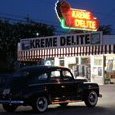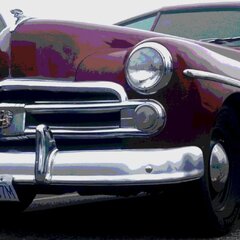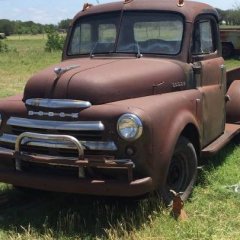All Activity
- Past hour
-
That's true. However, I've never used POR before. As for the Rustoleum products, specifically mentioned by TS, the best result I had was with their marine paint (applied with a brush). It is UV-resistant (for exterior panels) sands and polishes well, and does not come right off when you spill gas on it 😉
-
automotive paint cost is driven by the collision industry where in by 9 and out by 5 is the shop MO and time is money and the insurance calls the shots on time/material and overall process completely. HOWEVER I would say that 95% or better of hobbyists do not work to that schedule and therefore do not need these products specific to the short availability of the vehicle or shop access. NOR are they working rust issues and or panel repairs of banging out ripples, replacement parts by factory, LKQ or collision panel from a wrecking yard is the time paid for repairs, shops would loose their butts in the first week if repairs were as before. If you paying for those material, well that is your call but they are not needed outside the collision industry.
-
I can absolutely assure you the new paint processes are not cheaper!! The cost of modern, cross-linked auto finishes is staggering, often many hundreds of $$$'s per gallon when you include the necessary reducers and hardeners. Then you add several coats of extremely expensive clear. But the resulting finish is much more durable and flexible (and environmentally friendly) than the old systems such as lacquer and acrylic enamel. To call modern auto finishes "paint" is a misnomer, they should be regarded more as a plastic coating.
-
My response was in regard to the original post about painting floor pans. These are parts of the car that aren't visible once the vehicle is assembled and can accept finishes that you wouldn't apply to the exterior of a hood. One of the common treatments for floor pans is POR which is a relatively thick "paint" that is applied with a brush so the pans will have a durable, rust and chip resistant finish. Rustoleum and similar exterior paints are an inexpensive alternative to the higher-$$$ stuff like POR or multi-stage epoxy and well suited to our old buggies. https://por15.com/products/rust-preventive-coating
- Today
-
Looked it up, what I was describing appears to be the good-old lacquer paint application technique. The fact that many technologies are not used anymore, is heavily related to the production efficiency (cheaper) of the process. Not necessarily something one wants to aspire to
-
-
visit a body shop and video the spraying, drying, sanding, respray for each coat.....be a mighty short film what you describing is the primer/surfacers in prep for top coat finish. Only time between coats is the flash time and dependent on temp and solvents used, it never should be allowed to dry between coats, thus a thin coat that will not be so wet to run or sag and when flashed you build your next layer. A good spray job is often described as a controlled run. Spray paint in a can is not for exposed surfaces and in times when you need X color....there is little long term protection with the absence of hardener, you can use these rattle cans but do topcoat clear for the long run. Test compatibility of comingled material on any job. Rustoleum Appliance paint has it uses and I have used it on appliances, for that application, it is ideal. Holds up well to repeated washings.
-
Isn't the proper painting technique, actually, requires thinner paint layer? I was under impression that for general wear parts thin coat is the best (less prone to chipping, etc.) and when you need thicker finish (like on automotive body panels) you apply multiple thin coats, drying and sanding them in between 🤔
-
I've used Rustoleum and Tractor Supply's implement paint for rust "proofing" on many projects over the years. No paint will kill rust that isn't addressed but it can inhibit surface corrosion on clean surfaces. Two VW Beetle floor pans (inside and out) and running gear received the Rustoleum satin and gloss finishes and both have held up well for over twenty years. I usually use a brush because the paint can be applied thicker and the cost and mess is much less than spray cans. I've also bought quarts, thinned with mineral spirits and shot it with a spray gun when that was the best option.
-
Reading through this information, appears it will be more than a day involved. Guess I’ll get (2) dismounted and validate conformity first and try not to damage anything. thanks folks for the in-site!
-
I should have stated more clearly, that I am only referring to the sedans, the design with the continual slope from roof top to deck lid. The other style sedans may well be different all together in that area. But on these P15 sedans, the arm rests mount in the exact same position in relation to the rear wheel wells. I will have to do some actual part to part comparison to know for sure that they are exactly the same. But if anyone else if following this topic, and has patterns for the P15 sedan rear arm rest upholstery, I would sure like to get in contact with them.
-
As far as I know it's OEM, but not 100%. I bought the car with 29K miles on it, so I think a lot of it is original. Haven't had a chance to get back into fuel leak yet but will provide updates when I can.
-
And the compression is so low that high octane fuel isnt needed. However, I use to run 94 until they ruined it with ethanol. Now i just run 87.
-
I think the vacuum line is suppose to follow the head around the front, not over the head. As for the fuel, perhaps parts of the alloy disolved out of the metal, leaving a sponge-like material. Or what you are seeing is vapour condensing. That's my guess. The tops of these carbs do warp easily, I usually tap the metal between the bolt holes with a small hammer, then sand it flat on a true surface. The hammer makes it so you dont have to sand as much to get it flat.
-
Perhaps not, but we are talking the glory days of automotive production. And even today, everything is year make and model specific. Cars are full of proprietary garbage to dazel the consumer. Every 4 door car is different in the rear seating compared to its two door counterpart. It's inherent to its design. I'm not sure there is a single car produced today in both a two door and four door. But that's a different topic all together. As for a 2door d35 or p19, the arm rest mounts against a stationary panel, and so are flat on the back side. They are not upholstered either. The 4 door version doesnt have that luxury with a door beside it. I cant see a p15 being any different...
-
I'm a firm believer in using spray paint where it actually is needed ..... I use it often all the time ..... as far as epoxy appliance paint ..... nothing better or worse then straight up spray paint. I have used it for touch up paint on the wife white car ..... I see no sign it is better or worse then other spray cans .... just has a fancy name.
-
Oh, as there are black appliances, I thought it came in black.
-
Easier to see rust, later on? 😂😉
-
Thanks. Are you sure that's OEM, though? The reason I ask is because your distributor is upside-down (or did they change the setup on later models? 🤨) Have you had a chance to investigate the fuel leak any further? What if you put a screw with Teflon tape into that corner hole, is the gas still accumulating over there?
- Yesterday
-
I admit to being a odd bird .... yes I have a a spray can of epoxy white ..... I actually use it for touch up on the washer/dryer in the garage. I cant even imagine using it for the floors of my car ...... I say anything is better then nothing ..... just not my first or 10th choice. Nothing wrong with using it, just nothing I would set out intentionally to use in my vehicle .... Just white paint .... who paints their floors white?
-
All Mopar flat sixes (and 8's) can from the factory with Valve seats (hardened). NO need to change anything but maybe timing if you have been running a higher octane gas. They have No problem running non leaded gas- never did! 😁 DJ
-
I would like to update my flat head six engine 1947 to a modern engine with gas without lead. I have heard that it is necessary to change the valve seats to more modern ones that resist modern gas with high octane and without lead. I would like to know your opinion on this subject because the original valve seats in my car are built into the block. Thank you
-
Cannot say about floor pan usage but on steering wheels it had held up exceptionally! Flexing too much may cause issues?, but our steer wheels flex a lot, so?. They sell an off white that is somewhat close to the original off white factory used. DJ
-
That is correct.





